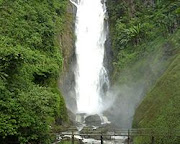An architecture for a self-adapting information
system for tourists
VASILIOS ZARIKAS1 , GEORGIOS PAPATZANIS1, CONSTANTINE STEPHANIDIS1,2
1 Institute of Computer Science
Foundation for Research and Technology - Hellas
Science and Technology Park of Crete
Heraklion, Crete GR-71110 Greece
e-mail: {vzarikas, gpap, cs}@ics.forth.gr
2 Department of Computer Science, University of Crete
Abstract: The paper briefly describes the design of the architecture of the PALIO system (Personalised
Access to Local Information and services for tOurists), focusing on the support for extensive adaptation. The framework provides a location-aware information system for tourists, capable of delivering fully adaptive information to a wide range of devices, including mobile ones. Its open and expandable architecture can integrate a variety of pre-existing or forthcoming services and retrieve information from a collection of different databases. It supports adaptability and dynamic adaptivity, according to user and context characteristics, both in the content and the presentation of information.
Introduction
The notion of universal access in the Information Society (Stephanidis et al., 1998; Stephanidis & Emiliani, 1999) is rooted on the concept of universal design, as it has evolved over the past decade. Universal design refers to the conscious effort to consider and take into account the widest possible range of end-user requirements throughout the development life-cycle of a product or service (Story, 1998). In recent years, universal design has been applied in interior and workplace design (Mueller, 1998), housing (Mace, 1998) and landscapes (Story, 1998). In the context of Human-Computer Interaction (HCI), design for all implies a proactive approach towards products and environments that can be accessible and usable by the broadest possible end-user population, without the need for additional adaptations or specialized (re-)design (Stephanidis & Emiliani, 1999). Building upon the results of earlier projects, such as ACCESS1 and AVANTI2 (Stephanidis et al., 2001), the PALIO project sets out to address the issue of anyone and anywhere access to community-wide services. This is an extension of previous efforts, as it accommodates a broader perspective on adaptation beyond desktop access. In what follows, we will briefly overview how this project addresses the issue of universal access and how it advances the current state of affairs by considering novel types of adaptation based on context and situation awareness.
The main challenge of the PALIO project is the creation of an open system for accessing and retrieving information without constraints and limitations (imposed by space, time, access technology, etc). Therefore, the system should be modular and capable of interoperating with other existing information systems. In this scenario, mobile communication systems play an essential role, because they enable access to services from anywhere and at anytime.
One important aspect of the PALIO system is the support of a wide range of communication technologies (mobile or wired) to access services. In particular, it will be possible for a user, who is equipped either with a common cellular phone or an advanced WAP phone, to access services from any place. This paper describes the types of adaptation that the PALIO system exhibits, as well as the architecture that supports the adaptation features specified below.
Adaptation and PALIO
The PALIO project proposes a new framework, which supports the provision of tourist services in an integrated open structure. The framework under consideration is capable of providing information from local databases in a user friendly and personalised way. The design of the architecture supports the following concepts:
1 TIDE-ACCESS TP1001 project (Development Platform for Unified Access to Enabling Environments), funded by the European Commission (DG XIII). The partnets in the ACCESS consortium are: CNR-IROE (Italy) - Prime contractor; ICS-FORTH (Greece); University of Hertforshire (United Kingdom); University of Athens (Greece); NAWH (Finland); VTT (Finland); Hereward College (United Kingdom); RNIB (United Kingdom); Seleco (Italy); MA Systems & Control (United Kingdom); PIKOMED (Finland).
2 ACTS-AVANTI AC042 project (Adaptable and Adaptive Interaction in Multimedia Telecommunications
Applications), funded by the European Commission (DG XIII). The partnets in the AVANTI consortium are: ALCATEL Siette (Italy) - Prime contractor; CNR-IROE (Italy); ICS-FORTH (Greece); GMD (Germany);
University of Sienna (Italy); MA Systems (UK); MATH-EMA (Italy); VTT (Finland); ECG (Italy); University of
Linz (Austria); TELECOM ITALIA (Italy); EUROGICIEL (France).
o Integration of wireless and wired technologies.
o Location awareness.
o Adaptation of the information content to meet user and context requirements.
o Adaptation of the user interface to meet user and context requirements.
o Context adaptation.
o Scalability of the information, and interoperability between the different services provided.
Adaptation at the context level refers to:
o Awareness of the environment where the user interacts (location, time, weather condition, noise, companions, description of the surrounding area).
o Awareness by the system of the particular device in use and proper response / communication with the client application / platform that the tourist uses for the communication.
o Awareness and reconciliation of bandwidths, of the status of wireless communication (Cheverest et al., 1998), of switching between different network providers (Ebling & Satyanarayanan, 1998), etc.
In PALIO, our aim is to construct a state of the art system that addresses the real requirements of tourists for assisted guidance. While, the HCI research community has successfully developed solutions for supporting the design of user interfaces for "static" contexts of use, this is not yet the case for mobile computing and for nomadic interaction (Johnson, 1998). PALIO attempts to provide solutions in this direction building upon the Unified User Interface Architecture (Stephanidis, 2001). The latter provides the required ground for the development of systems that are adaptable and adaptive to the individual end-user requirements in different contexts of use.
Since the interaction situations are dynamically changing, there is an explicit need for both "horizontal divergence" and vertical "specialisation" in the resulting response of the system, so that it will be able to capture the range of user and usage-context requirements). Therefore, different design alternatives will support the output, either within or across interaction sessions (Stephanidis, 2001).
Applications for mobile computing must be designed to cope with the level of uncertainty that is inevitably introduced (Rodden, 1998). This is true due to less connection stability, less predictable availability, and more latency. This is one of our motivations for employing adaptation via decision-making theory under uncertainty in the PALIO project.
For agents that require simple decision making logic, common "if-else" structures implemented with common programming, may suffice. However, the advanced adaptation features that PALIO needs to develop require a more sophisticated approach using knowledge representation frameworks, decision -making models based on statistical reasoning and probabilistic based decision models. These models should encompass learning, which results to intelligent decisions with better performance. In addition, sometimes inferences should be made based only on incomplete knowledge of all the relevant parameters.
There are, at a conceptual level, at least two types of adaptation that are realised in PALIO: "global" adaptation rules that can be applied across services (e.g., adaptation related to the output medium / modality); and "service specific" adaptations that are only applicable in the context of a particular domain / service.
Location-aware mobile multimedia guides have been developed so far (Long et al., 1996), (Davies et al., 1998), which provide information and interaction options according to the location point. The PALIO project fully supports adaptivity and adaptability according to the location point. The architecture of PALIO implements adaptivity proactively. This feature not only leads to meaningful adaptivity, but also
accommodates user-centred design. Furthermore, it allows the enhancement of the adaptive system with new user groups, new services and new interaction styles, after the implementation.
There are a number of important differences between the PALIO system and other contemporary tourist information systems. In the PALIO framework, the user client module does not keep any databases for information retrieval and there is no special pre-installed tourist client application in the devices. As a result, there are less resource demands from the user client.
The components
The system consists of five main building units:
(i) The Service Control Centre ( SCC) is the central block of the PALIO system. It serves as the access point, getting the request from the user. It also provides the runtime platform for the system information services.
(ii) The Generic Information Server (GIS) integrates existing or forthcoming local databases and manages existing information and services, which will be distributed over the network.
(iii) The Communication Layer . This module provides transparent communication between the user and the PALIO system. It unifies over the different communication protocols (WAP, http) and different terminal devices (cellular phones, internet PC's, kiosks, etc.)
(iv) The Adaptation Module is responsible for content and interface adaptation in the PALIO System.
o The Adapter provides the decision-making component of the system. It integrates information concerning the user, the context of use, the access environment and the interaction history, and makes decisions in order to adapt the information content and presentation accordingly.
o The User Model Server (UMS) integrates and manages information concerning user characteristics (e.g., interests, interaction styles), in the forms of both individual user profiles constructed during interactive sessions, and user stereotypes for groups of users that share a number of characteristics.
o The Context Model Server (CMS) assembles the context profiles, using information retrieved from the Usage Context Repository, and informs the adapter about the current context. It processes the information on the customer positioning that comes from GPS device or the mobile telecommunication network.
Information and control flow
The steps numbered and described below are related to the flow of both control commands and information contents in the system and analyse the various functionalities supported in the proposed architecture.
1. The request from the client reaches the SCC by means of the HTTP protocol through the communication layer. The communication layer transforms the request in an XML file and passes it to the SCC.
2. The SCC acquires from this request all the necessary information to satisfy the client (i.e., User Identification, User Agent, Location - for GPS devices- and type of request). If necessary, SCC acquires the client position from the mobile telecommunication network
3. The Adapter gets the information regarding the request, the user, the client device, the client agent and the location and passes it to the user and the context model servers. The adapter passes pieces of information describing parts of the request to the decision making engine.
4. The user model and context model servers update the user profiles and the context situations respectively, using the information coming from step 3.
5. The decision making engine, which holds adaptation rules (general and service specific) and a decision making model, requests and gets from the user-context model servers the appropriate user and context based information regarding interests and attributes.
6. A decision made by the decision making engine is mapped to proper adaptation actions regarding the construction of an adaptive request to the local databases.
7. The adaptation action is passed to the service control centre.
8. The request is adapted on the basis of the instructions coming from step 7 and an XML query is formulated.
9. The request is analysed by the generic information server in order to formulate the necessary query to interrogate the DB that contains the requested information.
10. The queries are forwarded to the Data sources
11. The information that the GIS provides in XML format is now collected from the SCC.
12. The response is assembled with the help of the instructions (adaptation actions regarding presentation) passed into the SCC from the decision making engine. This time, decisions have been made according to service specific and general rules concerning the presentation of the content.
13. The XML response (XML file plus stylesheets) is generated and passed to the communication layer in order to be transformed in the appropriate format (HTML, WML, SMS).
Concluding remarks
We have briefly described how the design of the adaptation infrastructure of PALIO seeks to advance a novel information system in tourist-oriented services. PALIO constitutes a substantial extension over previous efforts on universal access, since it introduces and explicitly accounts for novel types of adaptation and new interactive encounters beyond the desktop. Accordingly, it pursues an architectural model of interaction which is expected to be of wider applicability in service communities other than tourism.
Acknowledgments
The PALIO project (IST-1999-20656) is partly funded by the Information Society Technologies Programme of the European Commission – DG Information Society. The partners in the PALIO consortium are: ASSIOMA S.p.A. (Italy) - Prime Contractor; CNR-IROE (Italy); Comune di Firenze (Italy); FORTH-ICS (Greece); GMD (Germany); Telecom Italia Mobile S.p.A. (Italy); University of Sienna (Italy);
Comune di Siena (Italy); MA Systems and Control Ltd (UK); FORTHnet (Greece).
References
Cheverst, K., Davies, N., & Friday, A. (1998). Developing Interfaces For Collaborative Mobile Systems. In C.
Johnson (Ed.), Proceedings of the First Workshop on Human Computer Interaction with Mobile Devices,
Glasgow. On-line at: http://www.dcs.gla.ac.uk/~johnson/papers/mobile/HCIMD1.html#_Toc420818990
Davies, N., Mitchell, K., Cheverst, K., & Blair, G.S. (1998, March). Developing a Context Sensitive Tourist Guide.
Technical Report Computing Department, Lancaster University.
Ebling, M.R., & Satyanarayanan, M. (1998). On the Importance of Translucence for Mobile Computing. In C.
Johnson (Ed.), Proceedings of the "First Workshop on Human Computer Interaction with Mobile Devices",
Glasgow. On-Line: http://www.dcs.gla.ac.uk/~johnson/papers/mobile/HCIMD1.html#_Toc420818988
Johnson, P. (1998). Usability and Mobility; Interactions on the move. In C. Johnson (Ed.), Proceedings of the "First Workshop on Human Computer Interaction with Mobile Devices", Glasgow. On-line:
http://www.dcs.gla.ac.uk/~johnson/papers/mobile/HCIMD1.html#_Toc420818965
Long, S., Kooper, R., Abowd, G.D., & Atkeson, C.G. (1996). Rapid Prototyping of Mobile Context -Aware
Applications: The Cyberguide Case Study. In Proceedings of the 2nd ACM International Conference on
Mobile Computing (MOBICOM '96), Rye. New York: ACM Press.
Mace, R. (1998). Universal Design in Housing. Assistive Technology, 10, 21-28.
Mueller, J. (1998). Assistive Technology and Universal Design in the Workplace. Assistive Technology, 10, 37-43.
Rodden, T., Chervest, K., Davies, N., Dix A. (1998). Exploiting Context in HCI Design for Mobile Systems. In C.
Johnson (Ed.), Proceedings of the "First Workshop on Human Computer Interaction with Mobile Devices",
Glasgow. On-line:
http://www.dcs.gla.ac.uk/~johnson/papers/mobile/HCIMD1.html#_Toc420818967
Stephanidis, C. (2001). The concept of Unified User Interfaces. In C. Stephanidis (Ed.), User Interfaces for All - Concepts, Methods, and Tools (pp. 371-388). Mahwah, NJ: Lawrence Erlbaum Associates (ISBN 0-8058-2967-9, 760 pages).
Stephanidis, C., & Emiliani, P-L. (1999). Connecting to the information society: a European perspective.
Technology and Disability Journal, 10 (1), 21-44.
Stephanidis, C., Paramythis, A., Sfyrakis, M., & Savidis, A. (2001). A Case Study in Unified User Interface
Development: The AVANTI Web Browser. In C. Stephanidis, (Ed.), User Interfaces for All - Concepts,
Methods and Tools (pp. 525-568). Mahwah, NJ: Lawrence Erlbaum Associates. (ISBN 0-8058-2967-9, 760
pages).
Stephanidis, C., Paramythis, A., Sfyrakis, M., Stergiou, A., Maou, N., Leventis, A., Paparoulis, G., &
Karagiannidis, C. (1998). Adaptable and Adaptive User Interfaces for Disabled Users in the AVANTI Project.
In S. Trigila, A. Mullery, M. Campolargo, H. Vanderstraeten & M. Mampaey (Eds.), Intelligence in Services
and Networks: Technology for Ubiquitous Telecommunications Services - Proceedings of the 5th International
Conference on Intelligence in Services and Networks (IS&N '98), Antwerp, Belgium (pp. 153-166). Berlin:
Springer, Lecture Notes in Computer Science, 1430.
Story, M.F. (1998). Maximising Usability: The Principles of Universal Design. The Assistive Technology Journal,
10 (1), 4-12.










